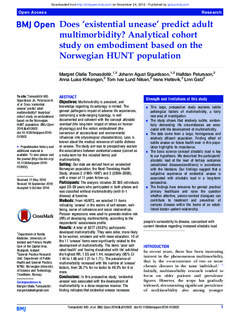| dc.contributor.author | Tomasdottir, Margret Olafia | |
| dc.contributor.author | Sigurdsson, Johann Agust | |
| dc.contributor.author | Petursson, Halfdan | |
| dc.contributor.author | Kirkengen, Anna Luise | |
| dc.contributor.author | Nilsen, Tom Ivar Lund | |
| dc.contributor.author | Hetlevik, Irene | |
| dc.contributor.author | Getz, Linn Okkenhaug | |
| dc.date.accessioned | 2016-11-24T13:15:35Z | |
| dc.date.accessioned | 2016-11-25T08:50:17Z | |
| dc.date.available | 2016-11-24T13:15:35Z | |
| dc.date.available | 2016-11-25T08:50:17Z | |
| dc.date.issued | 2016 | |
| dc.identifier.citation | BMJ Open 2016, 6:1-9 | nb_NO |
| dc.identifier.issn | 2044-6055 | |
| dc.identifier.uri | http://hdl.handle.net/11250/2423006 | |
| dc.description.abstract | Objectives: Multimorbidity is prevalent, and knowledge regarding its aetiology is limited. The general pathogenic impact of adverse life experiences, comprising a wide-ranging typology, is well documented and coherent with the concept allostatic overload (the long-term impact of stress on human physiology) and the notion embodiment (the conversion of sociocultural and environmental influences into physiological characteristics). Less is known about the medical relevance of subtle distress or unease. The study aim was to prospectively explore the associations between existential unease (coined as a meta-term for the included items) and multimorbidity.
Setting: Our data are derived from an unselected Norwegian population, the Nord-Trøndelag Health Study, phases 2 (1995–1997) and 3 (2006–2008), with a mean of 11 years follow-up.
Participants: The analysis includes 20 365 individuals aged 20–59 years who participated in both phases and was classified without multimorbidity (with 0–1 disease) at baseline.
Methods: From HUNT2, we selected 11 items indicating ‘unease’ in the realms of self-esteem, well-being, sense of coherence and social relationships. Poisson regressions were used to generate relative risk (RR) of developing multimorbidity, according to the respondents' ease/unease profile.
Results: A total of 6277 (30.8%) participants developed multimorbidity. They were older, more likely to be women, smokers and with lower education. 10 of the 11 ‘unease’ items were significantly related to the development of multimorbidity. The items ‘poor self-rated health’ and ‘feeling dissatisfied with life’ exhibited the highest RR, 1.55 and 1.44, respectively (95% CI 1.44 to 1.66 and 1.21 to 1.71). The prevalence of multimorbidity increased with the number of ‘unease’ factors, from 26.7% for no factor to 49.2% for 6 or more.
Conclusions: In this prospective study, ‘existential unease’ was associated with the development of multimorbidity in a dose–response manner. The finding indicates that existential unease increases people's vulnerability to disease, concordant with current literature regarding increased allostatic load. | nb_NO |
| dc.language.iso | eng | nb_NO |
| dc.publisher | BMJ Publishing Group | nb_NO |
| dc.rights | Navngivelse-Ikkekommersiell 3.0 Norge | * |
| dc.rights.uri | http://creativecommons.org/licenses/by-nc/3.0/no/ | * |
| dc.title | Does ‘existential unease’ predict adult multimorbidity? Analytical cohort study on embodiment based on the Norwegian HUNT population | nb_NO |
| dc.type | Journal article | nb_NO |
| dc.type | Peer reviewed | nb_NO |
| dc.date.updated | 2016-11-24T13:15:35Z | |
| dc.source.volume | 6 | nb_NO |
| dc.source.journal | BMJ Open | nb_NO |
| dc.identifier.doi | 10.1136/bmjopen-2016-012602 | |
| dc.identifier.cristin | 1402525 | |
| dc.description.localcode | This is an Open Access article distributed in accordance with the Creative Commons Attribution Non Commercial (CC BY-NC 4.0) license, which permits others to distribute, remix, adapt, build upon this work non-commercially, and license their derivative works on different terms, provided the original work is properly cited and the use is non-commercial. See: http://creativecommons.org/licenses/by-nc/4.0/ | nb_NO |

